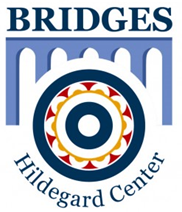Hands in Action
Hands in Action
A Lesson Inspired by the Teachings of Liz Shea-McCoy With a “Full-Body” Adaptation by Susan Brasch http://www.susanjbrasch.com Also included is a Link to the Copyrighted Dick Blick Lesson Plan Aboriginal Hand Prints www.dickblick.com which can also be found in this hub.
Objectives:
1. To Learn about the importance of hands
2. To identify the many uses of hands
3. To create art using hands (and other body parts) as both a vehicle and an inspiration
4. To incorporate the elements of color, pattern, line, symmetry and negative positive space into the creation of art
Audiences:
This lesson is appropriate for all ages and audiences but is ideal for elementary-aged children.
Learning Opportunities:
The hand is composed of 27 bones (carpals, metacarpals, and phalanges) which make up one quarter of all the bones in your body! Think of all the many uses for hands—they can squeeze, grip, and hold things. Hands make it possible for us to climb and use things such as hammers, saws, or rakes. They are used for touching, feeling, caressing and pointing. Hands can even be used to cover our eyes, point, wave, spell out words and communicate through gestures. They pluck strings on violins or harps and press keys to make music on the piano. We use our hands to feel—smooth, rough, scratchy, satiny, hot or cold. We can use our hands to help others—give a thumbs up or thumbs down to express an opinion—give a hand up to someone in need or a pat on the back for encouragement. AND, hands are used to create art—what a wonderful part of our bodies that help us in so many ways!
Supplies/Materials:
- Paper
- Colored pens, pencils, crayons, markers
Class Instruction:
1. Pass out paper and markers, crayons, etc. to the participants.
2. Start by tracing the hand of someone participating in the class onto a sheet of paper using a pen or pencil.
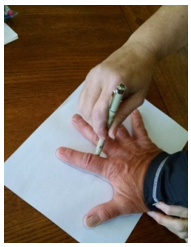
Hand tracing
3. Enlist the help of another person to add their hand to the paper, overlapping the previous hand tracing.
4. Ask a third person to help and remind the participants to trace their own hand as well! By tracing the hands at different angles and using different sizes of hands, the participants will come up with some interesting shapes and will have much help to complete the project.
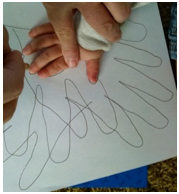
More Hands
5. Now it’s time to get to work. In all the little sections created by the tracings, start using markers, pens, pencils, crayons, etc. to fill in with color and design to create unique abstract hand art.
6. There is no “right or wrong” as the participants are filling in the spaces—just experiment and explore.
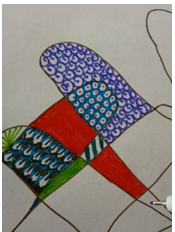
Example
7. When they’re all finished, your participants will have a wonderful abstract art creation that began with hands and was created by THEIR hands.
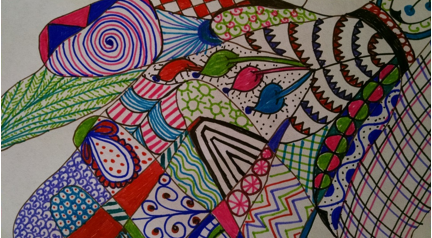
Finished Hand
Adaptations and Extensions:
Artist and Teacher Susan Brash took the “hands” art one step further and invited children to trace full bodies and body parts to create a school mural. Susan laid large sheets of butcher paper on the floor and invited her students to trace around various body parts using a washable black magic marker. After all the various parts were traced and overlapped, Susan invited her students to use markers and/or paint to bring the art to life with color.
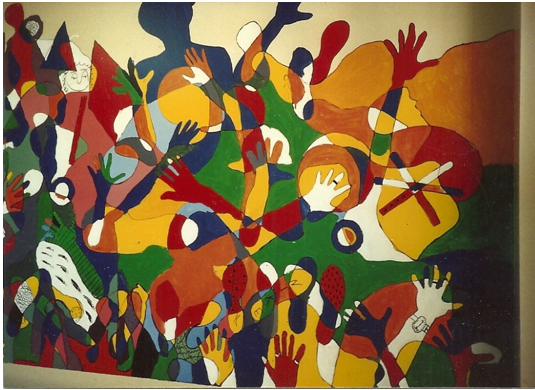
Finished Mural
Once the mural was completed, it was put on display at the school the children attended. Imagine the fun the kids had in joining forces as a community to create this special art for their school.
For another art activity involving hands courtesy of Dick Blick Art Materials, link to
http://www.dickblick.com/lesson-plans/aboriginal-hand-prints/ to access a wonderful lesson about Aboriginal Hand Prints or you can search for it within this hub. The stenciled handprint and aboriginal style drawings help children to relate to the Australian Aboriginal Culture while learning the use of Line in art.
Other Art Activities Using Hands:
- Ask your participants to trace their hands and then fill the hand with patterns or symbols that will communicate something about themselves. For instance, a musician may include musical notes and images of instruments.
- Consider placing a traced hand inside a circle to make a mandala. Next have the participants give “clues” about themselves as they decorate the mandala, incorporating symbols and words that are important to them.
- Ask the participants to draw their hands doing positive things—helping someone, offering encouragement or doing something productive.
- Make a collage using the participant’s hand as the focal point. Have the participant trace their hand on paper and cut it out—they can add fingernails and other lines if they’d like. Next the participant can pick out pictures from magazines, photos, mementos, etc. that has meaning to them and/or describes their personality or their life to create the collage. Insert the hand tracing in a prominent place in the collage to act as a focal point.
- Have each participant trace their hand and then, under the direction of the facilitator, counselor, etc. They can write in or create art for each finger to represent things such as the pillars of character (trustworthiness, respect, responsibility, fairness, and caring are five possible pillars—the participants may come up with others), positive attributes the participants recognize in themselves, attitudes they are working to improve, etc.
Special Thanks to Dick Blick for
graciously allowing Hildegard Center to link to DB lesson plans in conjunction
with its “Art Bridges” Project. Dick Blick’s commitment to the educational
community extends far beyond providing high-quality products at low
prices. DB offers art lesson plans
created for all ages and skill levels.
Every project also meets several National Standards for Visual Arts
education. PDF downloads and videos of
these original lessons are available free of charge. Visit www.dickblick.com to
see the many ways DB support schools, communities and art education and make DB
your one-stop shopping destination for art supplies
